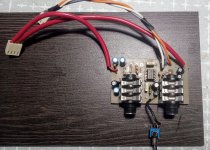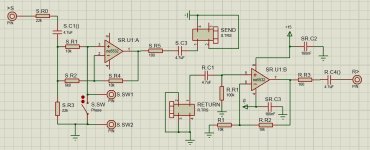Happy New Year 🙂
Of course it is not working, you cant have a one opamp circuit of great complexity running without spending days debugging and setting it up.

The return part now working for unknown reasons (I looked the pcb several times for wrong connections..)
The send part is taking signal out.
Of course it is not working, you cant have a one opamp circuit of great complexity running without spending days debugging and setting it up.
The return part now working for unknown reasons (I looked the pcb several times for wrong connections..)
The send part is taking signal out.
happy new year emosms..and all of you...forgive me emismos, but I have difficulty understanding which are the inputs, which are the outputs, what you want to mix and the signals you want to blend...maybe the CAD you're using...is no so clear.. If you can be more explain in simple words what do you need, drawing a simple block with input / output ...perhaps we can help you. Do you want to try? maybe someone can help you...un saluto Ros
Send is (always) an output (to an effects device).
Return is always an input (from an effects device).
Summing or mixing those connections otherwise is not intented by the designer nor the proper use of it.
Effects can be echo, delay, chores, equalizer and what not.
Send can be pre- or post-fade, called Monitor and FX, up fom nil to several (internal mixing) lines.
It becomes convenient when there are at least 6 - 8 free choise (pre/post) internal busses to address several demands from the stage.
And then 'reprocessed' from the Returns into the stage (monitor) or FOH (public) signals. Including the EQ, handling both the house and the stage.
Return is always an input (from an effects device).
Summing or mixing those connections otherwise is not intented by the designer nor the proper use of it.
Effects can be echo, delay, chores, equalizer and what not.
Send can be pre- or post-fade, called Monitor and FX, up fom nil to several (internal mixing) lines.
It becomes convenient when there are at least 6 - 8 free choise (pre/post) internal busses to address several demands from the stage.
And then 'reprocessed' from the Returns into the stage (monitor) or FOH (public) signals. Including the EQ, handling both the house and the stage.
WTF are you talking, this is a simple guitar amp and there are all tube solutions for 'send return' loop with so called 'dry-wet' mix.
They use double pots, send and return are on different pots and I don't think they can get that constant level at mid to end position of the pot (for the input that is not to be attenuated).
Tired of explaining a very basic idea SEVERAL times. If you put chorus, reverb, delay, some modulation, other effect, it is best to apply it after the preamp stage, especially if there is some gain/ distortion or the sound gets smeared.
Thats why you have FX send-return loop - it is between the preamp and the poweramp section.
Then, instead of setting the effect 'depth' (too complex and unhandy if it is a signal processor with menus), it is much easier to use the dry-wet/ crossfade mix pot.
Even if it is a stompbox with own pots, the effect may not allow easily setting the depth to a level YOU want, depends on the individual effect.
The crossfade mix solves the problem so you DONT care what the effect is, you mix the raw and the processed signal and YOU set the depth through the amp interface.
Soldering some 'probes' these days to try to use a PC based scope and follow the signal.
The pcb where the crossfade mixers is takes input (there is hum when I touch the 'return' input)
The send-return pcb takes signal out (the send 6.3'' jack takes signal out, tested).
So it is the return part on the send return module. It is so incredibly simple (just an opamp) but I still cant figure out why it is not working, while the other opamp in the same DIP8 (the send part) works.... 😵😵😵
They use double pots, send and return are on different pots and I don't think they can get that constant level at mid to end position of the pot (for the input that is not to be attenuated).
Tired of explaining a very basic idea SEVERAL times. If you put chorus, reverb, delay, some modulation, other effect, it is best to apply it after the preamp stage, especially if there is some gain/ distortion or the sound gets smeared.
Thats why you have FX send-return loop - it is between the preamp and the poweramp section.
Then, instead of setting the effect 'depth' (too complex and unhandy if it is a signal processor with menus), it is much easier to use the dry-wet/ crossfade mix pot.
Even if it is a stompbox with own pots, the effect may not allow easily setting the depth to a level YOU want, depends on the individual effect.
The crossfade mix solves the problem so you DONT care what the effect is, you mix the raw and the processed signal and YOU set the depth through the amp interface.
Soldering some 'probes' these days to try to use a PC based scope and follow the signal.
The pcb where the crossfade mixers is takes input (there is hum when I touch the 'return' input)
The send-return pcb takes signal out (the send 6.3'' jack takes signal out, tested).
So it is the return part on the send return module. It is so incredibly simple (just an opamp) but I still cant figure out why it is not working, while the other opamp in the same DIP8 (the send part) works.... 😵😵😵
Last edited:
Finally set some cables and connectors to use a PC scope.
The signal right after R.C1 (two opposite electrolytic caps actually) gets attenuated app. 5 times and no signal at the op-amp output.
When I turn off the power supply, the signal gradually gets back to normal...
Changed the opamp and input coupling caps, the same problem.
Something wrong with this extremely complex op-amp circuit...
Check that the inverting and non-inverting inputs show the same voltage / waveform for each opamp - if not something is broken.
+ input: -8.2 v
- input: 0 v
psu: +-15 v
No idea where that -8.2 v comes from at the non inverting input 🙁
- input: 0 v
psu: +-15 v
No idea where that -8.2 v comes from at the non inverting input 🙁
I set the circuit on a breadoard.
(eventhough I would really like to spend a negative amount of time on this, -5 days dealing with nonsense ******** minor **** would be nice renumeration).
It works. The last opamp that measured -8v on the input is gone, the other opamps work.
Added 1k resistor before the +input (some thoughts abt why it might not work/ one opamp gone).
Testing on the actuall pcb - seems to work.
Afraid to put it back in the chassis, there is some curse to waste more and more time on this minor ****, so I dont know what to expect...
(eventhough I would really like to spend a negative amount of time on this, -5 days dealing with nonsense ******** minor **** would be nice renumeration).
It works. The last opamp that measured -8v on the input is gone, the other opamps work.
Added 1k resistor before the +input (some thoughts abt why it might not work/ one opamp gone).
Testing on the actuall pcb - seems to work.
Afraid to put it back in the chassis, there is some curse to waste more and more time on this minor ****, so I dont know what to expect...
p.s. is it possible to see on the PC scope when I switch the phase, or the trigger would halt showing it?
I cannot make the pc scope work on 2 channels yet, to compare circuit input vs output.
The so called 'simulator' shows it works, comparing input and output on simulation scope.
But I dont see change with the real circuit and pc scope when flipping the switch, except amplitude difference.
I cannot make the pc scope work on 2 channels yet, to compare circuit input vs output.
The so called 'simulator' shows it works, comparing input and output on simulation scope.
But I dont see change with the real circuit and pc scope when flipping the switch, except amplitude difference.
Refer to #29. Your civilized & decent description of the very problem is much appreciated.WTF are you talking... with so called 'dry-wet' mix.
Tired of explaining a very basic idea SEVERAL times.
Even if it is a stompbox with own pots... The crossfade mix solves the problem
It is so incredibly simple (just an opamp) but I still cant figure out why it is not working, while the other opamp in the same DIP8 (the send part) works....
It works now, strangely the phase flip is not seen on scope (there is a flip in the circuit simulation virtual scope)
There is a tonal difference though, I cannot really describe it as a total phase cancelation and loss of dynamics/ bass, but one of the setting is more 'beefy'
There is a tonal difference though, I cannot really describe it as a total phase cancelation and loss of dynamics/ bass, but one of the setting is more 'beefy'
Civilized and decent up to a point I described it several times, struggling to make it work for days (I am very bad at electronics) and repeatedly getting side questions:
It is getting annoying after several days of struggle 😉
- why are u doing that
- what is it what you are doing (mixing two signals in general) and so on...
It is getting annoying after several days of struggle 😉
Congrats, you've mastered the electronics yourself.
So it can nearly cancel itself out, or 'add' something extra ('beefy).
Cheerio!
This can happen when the same signal is mixed with itself but one leg is out of phase. Depends on various pot settings.I cannot really describe it as a total phase cancelation and loss of dynamics/ bass, but one of the setting is more 'beefy'
So it can nearly cancel itself out, or 'add' something extra ('beefy).
Cheerio!
Have to learn how to use scope for troubleshooting and tunning.
I am at the next stage (smth like a crossover) and it seems it has some distortion problem.
Then one more final module (limiter), then start over from the preamp to the end adjusting here and there...
I am at the next stage (smth like a crossover) and it seems it has some distortion problem.
Then one more final module (limiter), then start over from the preamp to the end adjusting here and there...
- Home
- Source & Line
- Analog Line Level
- Mixer circuit problem

